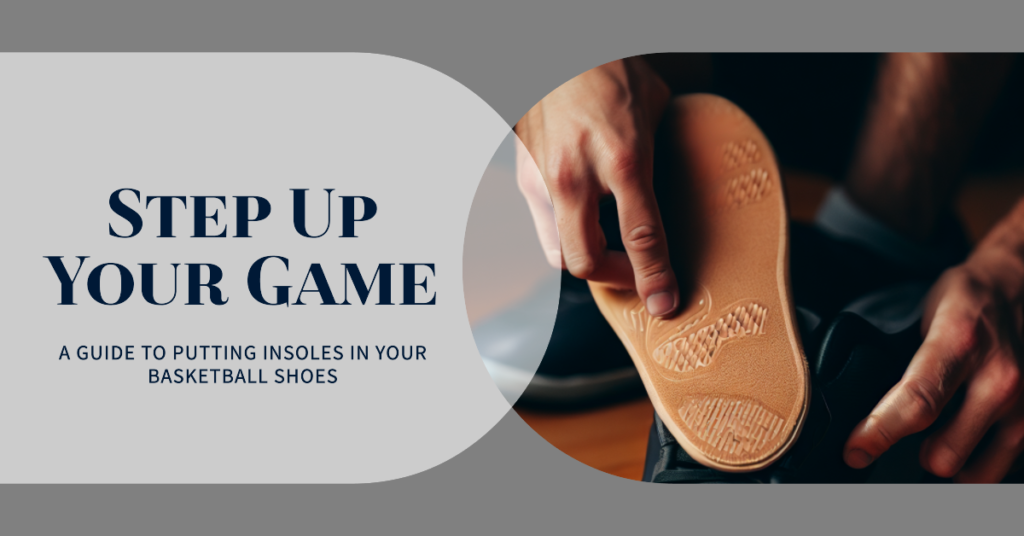To put insoles in basketball shoes, remove the existing ones and place the new ones flat and centered inside the boots. Basketball players often rely on their shoes for comfort and support during games.
However, over time, the cushioning in the insoles may wear out, resulting in reduced support and discomfort. In such cases, it is essential to replace the insoles to maintain optimal performance on the court. This article will guide you on adequately inserting insoles into your basketball shoes.
Following these simple steps, you can easily remove the old insoles and install new ones, ensuring comfort and support for your feet throughout your basketball sessions. So, let’s dive in and explore the proper technique for inserting insoles into your basketball shoes.
The Importance Of Comfort In Basketball
Basketball players understand the importance of comfort in their game. Learn to enhance your basketball shoes by correctly inserting insoles for optimal cushioning and support.
Basketball is a highly dynamic sport that requires agility, speed, and precision. Players must ensure they are comfortable in their basketball shoes to excel on the court. The right pair of shoes can significantly impact a player’s performance and overall experience.
One crucial element that contributes to comfort is the use of insoles. We will explore the importance of comfort in basketball and how to insert insoles into basketball shoes properly.
Enhancing Performance On The Court:
- Proper support: Insoles provide added arch support, which helps distribute pressure evenly along the foot. This can improve balance and stability, allowing players to make quick cuts, pivots confidently, and jumps.
- Shock absorption: Basketball involves a lot of running, jumping, and landing, which can put a significant strain on the feet and joints. Insoles with cushioning properties absorb shock and reduce the impact of these movements, minimizing fatigue and enhancing performance.
- Alignment correction: Insoles can correct misalignments and properly align the feet, ankles, and lower limbs. This alignment ensures better stability and optimal movement mechanics, reducing the risk of injury and enhancing performance.
Preventing Injuries And Discomfort:
- Reduced foot fatigue: Basketball games and practices can be physically demanding, leading to foot fatigue and discomfort. Insoles can help alleviate this fatigue by providing additional cushioning and support, allowing players to stay on their feet longer without pain.
- Injury prevention: The repetitive basketball movements can lead to various foot and lower limb injuries. Insoles can help prevent injuries such as shin splints, plantar fasciitis, and stress fractures by reducing the impact on the feet and providing proper support and alignment.
- Blisters and friction reduction: Intense physical activities like basketball can cause friction and hotspots, leading to painful blisters. Insoles with moisture-wicking properties and anti-friction materials can reduce the risk of blisters, keeping the feet comfortable and allowing players to focus on the game.
Correctly inserting insoles into basketball shoes can significantly enhance a player’s comfort and overall performance on the court. By providing support, shock absorption, alignment correction, and injury prevention, insoles play a vital role in keeping players comfortable and free from foot-related issues.
So, take the time to find the right insoles for your basketball shoes and enjoy the game with the utmost comfort and confidence.

Credit: www.amazon.com
Understanding Insoles For Basketball Shoes
Basketball shoe insoles are essential for comfort and support during the game. Learn to properly insert insoles in your basketball shoes for an improved playing experience. Find out the steps and tips to ensure a perfect fit and maximize performance on the court.
Basketball is an exciting and physically demanding sport that requires the right equipment to maximize performance and protect against injuries. One essential component of basketball gear is insoles, which provide additional support, cushioning, and comfort for your feet while playing on the court.
If you’re wondering how to put insoles in basketball shoes, this article will guide you. Before diving into the steps, let’s first understand the different insoles available for basketball shoes.
Types Of Insoles Available:
- Arch Support Insoles: These insoles are designed to provide extra support to your arches. They help distribute pressure evenly across your feet and reduce the risk of developing foot conditions like plantar fasciitis.
- Gel Insoles: Gel insoles offer excellent shock absorption, cushioning your feet from the impact of jumps and sudden movements on the basketball court. They provide enhanced comfort and relieve pressure from high-impact areas.
- Orthotic Insoles: Orthotic insoles are prescribed by healthcare professionals to correct specific foot conditions or abnormalities. They are custom-made to address individual foot issues and improve overall foot alignment.
- Performance Insoles: Performance insoles are designed with advanced technology to enhance athletic performance. They provide superior cushioning, stability, and energy return to help you perform at your best on the court.
- Heat-Moldable Insoles: These insoles are made from a material that can be heated and molded to your foot shape, providing a customized fit for maximum comfort and support.
Now that you better understand the different insoles available, the next step is to choose the right ones for your needs.
Choosing The Right Insoles For Your Needs:
- Consider your foot type: Determine whether you have high arches, flat feet, or neutral arches. This information will help you select insoles that offer the appropriate support and stability for your foot structure.
- Assess your playing style: Think about your style and the specific movements on the court. If you’re an explosive player who frequently jumps and lands, gel insoles with excellent shock absorption might be a good choice. If you need extra arch support, opt for insoles designed for this purpose.
- Seek professional advice: If you have pre-existing foot conditions or chronic foot pain, consult a podiatrist or orthopedic specialist. They can recommend orthotic insoles or guide the best insoles to alleviate your symptoms.
- Try different options: Try other insoles and see which ones are most comfortable and supportive for your feet. Consider factors such as cushioning, stability, and overall fit when deciding.
Before purchasing the chosen insoles, there are a few key factors to consider.
Factors To Consider Before Purchasing:
- Size: Ensure that the insoles you choose match the size of your basketball shoes for a proper fit. Too big or small insoles can cause discomfort and affect your performance.
- Material: Look for insoles made from durable, breathable fabrics that withstand basketball demands. Moisture-wicking properties can help keep your feet dry and prevent odor.
- Thickness: Consider the thickness of the insoles and how they will fit within your basketball shoes. Insoles that are too thick may affect the fit of your shoes, while those that are too thin may not provide adequate support.
- Compatibility: Some insoles may be designed for certain shoe brands or models. Ensure that the insoles you choose are compatible with your basketball shoes for optimal performance.
By following these guidelines, you can select the right insoles for your basketball shoes, improving overall comfort, support, and performance on the court. Investing in quality insoles is a small step that can make a big difference in your game.
How To Properly Insert Insoles In Basketball Shoes
Discover the correct way to insert insoles into your basketball shoes with these simple steps. Enhance your comfort and performance on the court by following our expert tips.
Whether you’re a professional athlete or a recreational player, having the proper support and comfort is essential for optimal performance on the basketball court. One way to enhance the fit and feel of your basketball shoes is by using insoles.
These inserts can provide additional cushioning, arch support, and stability, allowing you to move confidently. This section will guide you through inserting insoles into your basketball shoes correctly, ensuring a snug and supportive fit.
Removing Existing Insoles (If Any):
- Check if your basketball shoes already have insoles. If they do, removing them before inserting new ones is essential.
- Gently pull out the existing insoles from your shoes. They are usually placed on top of the shoe’s midsole, beneath the sock liner.
- Inspect the removed insoles for any signs of wear and tear or deformities. If they are damaged, replacing them with new ones is recommended.
Placing The Insoles Correctly In The Shoes:
- Take the new insoles and position them over the shoe’s midsole, aligning them with the shape of your feet. Ensure that the heel portion of the insole matches the shoe’s heel.
- Press down on the insoles, starting from the heel and moving towards the toe, to secure them. Make sure they lie flat and don’t bunch up or fold.
- Ensure that the insoles cover the entire length of the shoe, from heel to toe, without overlapping or extending beyond the shoe’s boundaries.
- If the insoles are too long for your shoes, trim them using scissors, following the manufacturer’s guidelines. It’s essential to follow the instructions to avoid damaging the insoles.
Ensuring A Snug Fit:
- Put on your basketball shoes with the newly inserted insoles.
- Lace up your boots tightly, ensuring a snug fit that supports your feet and ankles.
- Walk around and keep the insoles in place without uncomfortable sliding or bunching up.
- Pay attention to how the insoles feel in terms of comfort and support. If there are any noticeable discomfort or fit issues, you might need to reposition the insoles or consider different ones that better suit your needs.
Following these simple steps, you can adequately insert insoles into your basketball shoes, enhancing support, comfort, and overall performance on the court. Remember to choose insoles that match your needs and consult a podiatrist or athletic specialist if you have any underlying foot conditions or concerns.
You’ll be well-equipped to take your basketball game to the next level with the right insoles.
Tips For Maximizing Comfort With Insoles In Basketball Shoes
Discover some valuable tips and tricks on correctly putting insoles in basketball shoes, ensuring maximum comfort on the court. Get expert advice on the proper techniques to enhance your performance and prevent injuries.
Basketball can be a high-impact sport that takes a toll on your feet. That’s why investing in a good pair of insoles for your basketball shoes is crucial. Not only do they provide extra support and cushioning, but they can also help prevent injuries and improve overall comfort.
Here are some helpful tips for maximizing comfort with insoles in your basketball shoes:
Proper Care And Maintenance Of Insoles:
- Remove the insoles: After each game or practice session, take out the insoles from your basketball shoes. This allows them to air out and prevents moisture and odor buildup.
- Clean regularly: Just like your shoes, insoles can accumulate dirt and sweat over time. Clean them regularly by hand washing with mild soap and warm water. Avoid machine washing as it might damage the materials.
- Air dry thoroughly: After cleaning, dry the insoles before placing them back into your basketball shoes. This helps prevent the development of mold or mildew.
- Rotate between pairs: If you have multiple pairs of basketball shoes, it’s a good idea to rotate the use of your insoles between them. This extends the insoles’ lifespan and ensures that they don’t become compressed in one shoe.
Replacing Insoles Regularly:
- Monitor wear and tear: Keep an eye on the condition of your insoles. If you notice any significant signs of wear and tear, such as flattened cushioning or visible cracks, it’s time to replace them.
- Follow the manufacturer’s recommendations: Different insoles have varying lifespans depending on the materials used and the usage level. Refer to the manufacturer’s recommendations on when to replace your insoles for optimal comfort and support.
- Consider shoe size changes: If you’ve recently changed shoe sizes or experienced foot growth, your current insoles may not fit properly. In this case, it’s essential to replace them to ensure the best fit and support.
Customizing Insoles For Personalized Comfort:
- Orthotic evaluation: Consider getting an orthotic assessment from a podiatrist or sports therapist. They can assess your feet and recommend custom-made insoles that address specific foot conditions or imbalances.
- Trim to fit: Many insoles have guidelines for trimming to fit your shoe size. Follow these instructions carefully to ensure proper alignment and support for your feet.
- Experiment with thickness and material: Insoles come in various thicknesses and materials. If you’re not completely satisfied with the initial comfort, try different options to find the perfect combination of cushioning and support.
Following these tips can ensure a comfortable and enjoyable basketball experience while minimizing the risk of foot-related discomfort and injuries. Remember that each person’s feet are unique, so don’t hesitate to explore different options until you find the best insoles.
Additional Ways To Enhance Comfort In Basketball Shoes
Insoles can significantly improve the comfort of your basketball shoes. Adding insoles can enhance cushioning, reduce foot fatigue, and prevent injuries during intense games and practices.
Finding the perfect pair of basketball shoes is crucial for any player, but sometimes even the best shoes don’t provide the comfort needed to perform at your best on the court. Luckily, there are several additional ways to enhance the comfort of your basketball shoes.
You can ensure maximum comfort and support by selecting the correct size and fit, utilizing proper lacing techniques, and incorporating foot stretches and exercises. Let’s dive into each of these methods to help you experience ultimate shoe comfort:
Selecting The Right Shoe Size And Fit
- Measure your feet: Using a Brannock device or a measuring tape, determine the length and width of each foot. This will help you find the appropriate shoe size.
- Try them on: Don’t rely solely on the shoe size. Different brands and styles may fit differently, so trying on basketball shoes before purchasing them is essential.
- Wiggle room is crucial: Ensure your toes have enough space to wiggle comfortably without cramped. This allows for better blood flow and prevents discomfort during quick movements on the court.
- Consider the arch support: Depending on your foot arch type (low, neutral, or high), look for basketball shoes that offer appropriate arch support to enhance comfort and prevent potential injuries.
Utilizing Proper Lacing Techniques
- Experiment with lacing patterns: Different lacing techniques can improve the fit and comfort of your basketball shoes. Try the “heel lock” method, where the laces cross at the top eyelets, creating a secure fit around the heel.
- Customize the tightness: Adjust the laces to your liking, ensuring a snug fit without causing discomfort or restricting blood circulation.
- Relieve pressure points: If you experience discomfort in specific areas, such as the top of your foot or around the ankles, skip lacing the corresponding eyelets to alleviate pressure.
Incorporating Foot Stretches And Exercises
- Toe stretches: Sit down and interlace your fingers between your toes, gently pulling them apart. Hold for a few seconds and repeat several times. This exercise helps relieve foot tension and enhances flexibility.
- Calf stretches: Stand facing a wall, placing one foot forward with the knee slightly bent. Extend the other leg back, keeping the knee straight and both feet flat. Lean forward, feeling the stretch in your calf muscle. Hold for 20-30 seconds on each side.
- Foot strengthening exercises: Perform exercises like toe curls and heel raises to strengthen the muscles in your feet. Stronger foot muscles provide better support and can reduce fatigue during basketball games.
Enhancing the comfort of your basketball shoes goes beyond just selecting the right pair. By focusing on the proper shoe size and fit, utilizing effective lacing techniques, and incorporating foot stretches and exercises into your routine, you can take your shoe comfort to the next level.
Try these additional methods and take your performance on the court to new heights.
Frequently Asked Questions On How To Put Insoles In Basketball Shoes
Can You Put Insoles In Basketball Shoes?
You can use insoles in basketball shoes to improve comfort and support.
How Do You Attach An Insole To A Shoe?
To attach an insole to a shoe, follow these steps: 1. Remove the existing insole. 2. Place the new insole in the shoe, aligning it with the heel and arch. 3. Press down firmly to ensure the insole sticks to the shoe’s interior.
4. Repeat the process for the other shoe to complete the attachment of the insoles.
How Do You Change The Insoles On Basketball Shoes?
To change the insoles on basketball shoes, follow these steps: 1. Remove the old insoles from the shoes. 2. Insert the new insoles, making sure they fit correctly. 3. Adjust the insoles for maximum comfort and support. 4. Lace up the shoes and check for a secure fit before playing basketball.
Should I Wear Insoles For Basketball?
Yes, wearing insoles for basketball can provide added support and comfort to enhance performance and reduce the risk of injuries.
Conclusion
To conclude, adding insoles to your basketball shoes can significantly improve your performance on the court. Not only do they provide extra cushioning and support, but they also help prevent injuries and alleviate discomfort. Following the step-by-step guide outlined in this blog post, you can quickly and effectively put insoles in your basketball shoes.
Remember to choose the right type of insole that suits your needs and preferences, whether for arch support, shock absorption, or odor control. Also, properly clean and maintain your insoles to ensure their longevity. Investing in high-quality insoles is a small price to pay for the enhanced comfort and performance they offer.
So, lace up your shoes, insert your insoles, and get ready to take your game to the next level on the basketball court!






